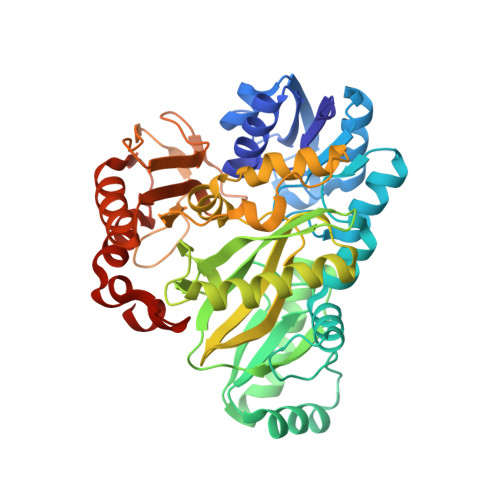Structural and biochemical studies on the regulation of biotin carboxylase by substrate inhibition and dimerization.
Chou, C.Y., Tong, L.(2011) J Biological Chem 286: 24417-24425
- PubMed: 21592965
- DOI: https://doi.org/10.1074/jbc.M111.220517
- Primary Citation of Related Structures:
3RUP, 3RV3, 3RV4 - PubMed Abstract:
Biotin carboxylase (BC) activity is shared among biotin-dependent carboxylases and catalyzes the Mg-ATP-dependent carboxylation of biotin using bicarbonate as the CO(2) donor. BC has been studied extensively over the years by structural, kinetic, and mutagenesis analyses. Here we report three new crystal structures of Escherichia coli BC at up to 1.9 Å resolution, complexed with different ligands. Two structures are wild-type BC in complex with two ADP molecules and two Ca(2+) ions or two ADP molecules and one Mg(2+) ion. One ADP molecule is in the position normally taken by the ATP substrate, whereas the other ADP molecule occupies the binding sites of bicarbonate and biotin. One Ca(2+) ion and the Mg(2+) ion are associated with the ADP molecule in the active site, and the other Ca(2+) ion is coordinated by Glu-87, Glu-288, and Asn-290. Our kinetic studies confirm that ATP shows substrate inhibition and that this inhibition is competitive against bicarbonate. The third structure is on the R16E mutant in complex with bicarbonate and Mg-ADP. Arg-16 is located near the dimer interface. The R16E mutant has only a 2-fold loss in catalytic activity compared with the wild-type enzyme. Analytical ultracentrifugation experiments showed that the mutation significantly destabilized the dimer, although the presence of substrates can induce dimer formation. The binding modes of bicarbonate and Mg-ADP are essentially the same as those to the wild-type enzyme. However, the mutation greatly disrupted the dimer interface and caused a large re-organization of the dimer. The structures of these new complexes have implications for the catalysis by BC.
- Department of Life Sciences and Institute of Genome Sciences, National Yang-Ming University, Taipei 112, Taiwan.
Organizational Affiliation:


















